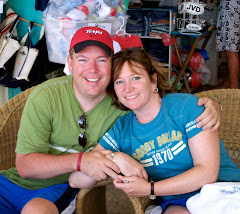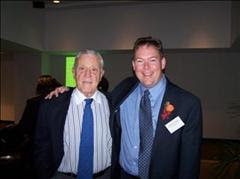Finding Middle Ground
01/28/08
By Jennifer Broadwater
Maryland Family Magazine
When Tom Saunders first tells acquaintances that he's principal of a middle school, he often gets the same responses: "God bless you" or "Oh, I'm so sorry."
He shrugs off the comments because he considers his job at Elkridge Landing Middle School a "badge of honor."
"I think I understand it's such a vulnerable age," he says. "It's so interesting to see a student come in as a child and transform into a young adult."
Middle school is a time of hormones, cliques, pimples and insecurity.
Hammond Middle School teacher Cecilia Haley says you couldn't pay her enough to be a middle schooler again, while Glenwood Middle School teacher George Lovera calls it the "worst three years" of his life.
But these teachers and many others choose to spend their careers back in middle school. Why? Veteran teachers like Haley and Lovera say middle school students are easy to love. They wouldn't trade their jobs for any other.
"There's so much change going on and it's rewarding to help them go through that," explains Saunders. "This is the time period when their wings start to flutter. Sometimes it's beautiful to see, other times it's really awkward while they figure it out."
Harper's Choice Middle School teacher Joe Fisher's trials in middle school motivated him to teach that age. He remembers being terrorized on his way home from middle school -- older kids would bully him for money and tempt him to engage in petty crime. And although it was more than 40 years ago, he knows that his students today aren't immune to the same type of bullying -- one of the many bumps that make middle school a time so memorable that many adults wish they could forget it.
"It was a time when I wasn't really sure about myself," says Fisher, who teaches social studies. "It's a really challenging period of life."
Most of these veteran teachers would agree that it takes a little empathy to walk the halls of a middle school every day. Early adolescence is a period of immense developmental change -- second only to the first years o f life, according to a compilation of research posted on the Web site of the National Middle School Association.
Chief among early adolescents' transformation are physical growth and puberty. Not only are these 10- to 15-year-olds sprouting, but they are also maturing intellectually and developing greater reasoning abilities -- a trait middle school educators notice in their students' strong sense of justice and focus on fairness, according to Saunders.
Middle schoolers are also more likely to seek independence from their parents and approval from peers. This makes them vulnerable to high-risk behaviors such as experimenting with alcohol, drugs and sexual activity, according to research posted on the National Middle School Association's Web site. (The research includes C. Stevenson's "Teaching Ten to Fourteen Year Olds," T. Knowles' and D.F. Brown's "What Every Middle School Teacher Should Know" and R.D. Kellough's and N.G. Kellough's "Teaching Young Adolescents: Methods and Resources for Middle Grades T eaching.")
In order to not only survive but thrive in a middle school, Windsor Mill Middle School teacher Johnna Alexander often reminds herself that, "The child who's the most difficult to love often needs it the most."
"I think the middle school child comes with an invisible sign that says, 'Make me feel important.' If teachers can remember that, then they've won half the battle," says Alexander, who began teaching science eight years ago as a second career, after having been a blues drummer.
"They're about as ornery as I am, so we get along," she jokes. "I think what happens is their focus really changes from being fascinated with the world around them to a fascination with self."
Lovera, a social studies teacher at Glenwood Middle, agrees. In his words, middle school-age children temporarily lose their "peripheral vision."
"You could be the most popular, with-it person in the world -- you could be Jesus, Buddah, Moses incarnate coming back to Earth and you wouldn't be able to change their perc eption of the world," says Lovera. "The challenge is to figure out how to get them to understand how they fit in -- not just in (their community) or Maryland, but the world."
In order to make his lessons relevant to his charges, Lovera is a keen observer of his students. He foregoes the teacher's lounge in favor spending his lunch break in the cafeteria. He builds relationships with his students outside the formal classroom environment and soaks in their behavior, interactions and trends.
"To really understand a middle school student, go to the lunch room. You'll see everything you need to know," he says.
Middle-schoolers are compelled to be accepted and included by their peers.
"It's all about the big group," says Haley, a reading teacher at Hammond Middle, in North Laurel. "They're spending so much time wondering what other people think, whether they're wearing the right clothes or listening to the right music. ... These are great kids, but they get caught up so much in wanting to be accepted that they can become mean to others."
With all of these physical, social and emotional distractions, it's no wonder there's a documented slump in academic achievement during the middle school years, according to research and evidence in local test scores. Results of Maryland's state-mandated exams in math and reading have shown general dips in students' pass rates during middle school since the tests were introduced in 2003.
For instance, during the most recent testing in 2007, the percentage of students statewide who passed the math test rose by each grade level in elementary school, but dropped from a roughly 78 percent pass rate in fifth grade to a 72 percent pass rate in sixth grade, then steadily decreased to a 57 percent pass rate by eighth grade. The pass rate then rose to 64 percent once students were tested in algebra in high school. Pass rates in reading followed a similar trend.
Keleigh Kongkraphun, a guidance counselor at Sudbrook Magnet Middle School near Pikesville, says middle schoolers can b e distracted from learning for a variety of reasons. They might lack organization skills and be inexperienced in handling responsibilities or be distracted by events that occurred at home or between classmates.
"If they come in upset about something, before they can go off and concentrate, they need to get that off their chest," she says.
The challenges of working in middle schools nationally led educators to launch online chat rooms and listservs, such as one called MiddleWeb, where teachers share ideas, ask for advice and commiserate.
One common discussion is finding outlets for middle-schoolers' abundant energy and advice includes keeping them engaged in hands-on activities in the classroom as well as clubs, sports and lessons after school.
At Windsor Mill, staff members have organized a popular after-school Wolfpack Discovery Program in which students may remain at school until 6 p.m. two days a week to participate in homework help, clubs or recreational programs. Teachers volunteer their time to oversee the activities and students pay just $3 for the bus ride home.
Fisher, of Harper's Choice Middle, hopes to keep middle school-age teens engaged in their education by providing them with adult mentors and a homework club. He says teaching middle school and keeping tabs on the participants in his mentoring program keeps him feeling young and gives him hope.
"At the end of the day, you are smiling," Fisher says. "These kids have lots of energy, and it takes lots of energy to keep up. They're a lot of fun, and I have really enjoyed listening to their ideas. It helps me realize the future looks good."
 On July 24th and 25th, I had the opportunity to attend the Mid-Atlantic Handheld and Emerging Technology Conference, fondly known as MAHETC, with several other colleagues and friends from my school district. Thanks Carol for inviting me to attend. http://www.seaford.k12.de.us/mahc
On July 24th and 25th, I had the opportunity to attend the Mid-Atlantic Handheld and Emerging Technology Conference, fondly known as MAHETC, with several other colleagues and friends from my school district. Thanks Carol for inviting me to attend. http://www.seaford.k12.de.us/mahc























